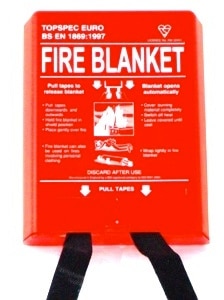Fire on a Sailboat
Fast Action
Putting out fires quickly is essential. The sooner you find the source the quicker the fire can be extinguished. Crew knowledge of the location of fire extinguishers and fire blankets is paramount. Placement of these items with large clear signs should be carefully designed for ease and speed of access.
Immediately alert the entire crew. This is called “sounding the alarm”.
Many countries’ laws require fire blankets to be installed on board. Law or not, fire blankets are a good idea. Fire blankets should be located near the stove and in each cabin that does not have a second way of getting out. A fire blanket should not be mounted above the stove. This would require you to reach through the fire to access the blanket. You can use a fire blanket to throw over a fire to smother it out or you can wrap yourself in the fire blanket to move quickly through a fire. Ensure your crew knows what a fire blanket is and where it is stowed.
Prevention
On the water, fire can be the death of you and your crew. Thus, it is overly important to take all preventative measures.
Electrical
- A leading cause of electrical fire is the AC plug to the boat. It is often not secured properly and thus leads to sparks and shorts. Each time you leave the boat, make sure the AC plug is securely fastened.
- Turn off nonessential electrical circuits when leaving the boat.
- Ensure your boat is properly fitted with an easy-to-reach and easy-to-find switch that disconnects the batteries from the DC system. When a DC electrical fire breaks out this switch is your first defense at extinguishing the source of the fire.
Stoves
- Turn off the gas supply to cookers when not in use.
- Do not leave the cooker unattended when in use.
- Do not leave items close to the cooker.
- Take extra caution with cooking oils and fats. Especially because the boat may be rocking.
- Take extra care with children cooking.
- Train on the use of a fire blanket.
Smoking
We understand the addiction but we’re talking about the lives of you and your crew. Smoking cigarettes in the cabins below should never be done. Never! If you must smoke, do so outside. But even still, take note that when smoking off the aft end of the boat, the smoke circles back upwind through the cockpit. Be considerate. If you’re a professional Captain, you’re not acting professionally if you smoke when guests are onboard – even if you ask their permission.
Detectors
Smoke detectors should be fitted in the main cabins and each sleeping cabin for early detection.
Gas alarm systems are easy to install on a vessel and detect LPG spilled over from the stove. Since LPG is heavier than air, it can collect in the bilges over time. If the gas alarm sounds:
- Make the crew aware of dangerous gas.
- Vent the area by opening hatches.
- Turn off the LPG tank.
- Don’t use any electrical devices.
- Don’t activate the electric bilge pump. Any electric device can cause an electric spark.
Causes
The marine insurance statistics below demonstrate that electrical wiring and appliances are by far the leading cause of boat fires. It’s important to understand that the flammable nature of most boat components renders them particularly vulnerable to flames no matter the source of ignition.
- AC and DC wiring/appliance 55%
- Engine/Transmission Overheating 24%
- Fuel Leaks 8%
- Miscellaneous 7%
- Unknown 5%
- Stove 1%
Fire Categories
Fires are categorized by a letter designation of their class. For example A or B or C etc.
But just to confuse you, the letter categorization changes by country. Fortunately, the universal nature of fire is consistent across the world. That is, fires are fueled by the following distinctly separately identifiable sources:
- Combustible materials such as paper, wood, cardboard, most plastics and including fiberglass epoxy
- Flammable liquids such as gasoline, kerosene, grease and oils
- Flammable gases
- Electrical current
- Combustible metals
- Cooking Oil and fat
| Fuel/heat source | North America | European | UK | Australian/Asian |
|---|---|---|---|---|
| Ordinary combustibles | Class A | Class A | Class A | Class A |
| Flammable liquids | Class B | Class B | Class B | Class B |
| Flammable gases | Class C | Class C | Class C | |
| Electrical equipment | Class C | Unclassified | Unclassified | Class E |
| Combustible metals | Class D | Class D | Class D | Class D |
| Cooking oil or fat | Class K | Class F | Class F | Class F |
On a sailboat, mostly you will deal with the first three types: Combustible materials, flammable liquids, and flammable gasses. That is Class A and B for North America and Class A, B, and C for the rest of the world.
While electrical is a source, once the electrical source has been isolated and eliminated the combustible material fueling the fire will fall into the categories above. For North America, the distinction is made with Class C extinguishers because the extinguishing material must be non-conductive. However, regardless of the non-conductivity of the extinguishing material, the electrical culprit of the fire must be eliminated from the circuitry by shutting down breakers or closing off battery bank switches in order to effectively put out the fire.
Fires with cooking oil and fat are handled best with a fire blanket, but can also be extinguished using Class B (flammable liquid – see next page) extinguishers.








